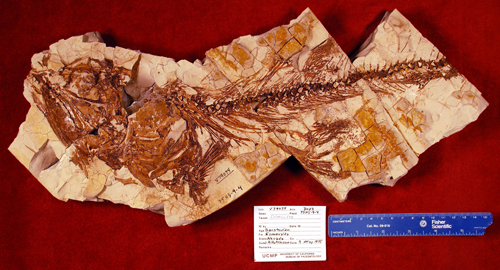 It is pretty unusual to see fish in the UCMP. It’s not that we don’t have any fish specimens — we have over a million fossilized fish fragments. It’s just that none of our museum scientists focus on fish, and so the museum’s fish parts tend to stay in the cabinets. But this past summer, Ralph Stearley of Calvin College visited the UCMP, and he did a little fishing.
It is pretty unusual to see fish in the UCMP. It’s not that we don’t have any fish specimens — we have over a million fossilized fish fragments. It’s just that none of our museum scientists focus on fish, and so the museum’s fish parts tend to stay in the cabinets. But this past summer, Ralph Stearley of Calvin College visited the UCMP, and he did a little fishing.
Ralph pulled some spectacular specimens from the murky depths of the cabinets. The two specimens shown here are exceptional — nearly all the bones are in place, and one of the specimens even has imprints of scales! It is really rare for fish to fossilize like this — most of the time, fish break apart into individual bones and tiny scales.
These two specimens are salmonids. They are related to salmon, char, and trout — their closest living relative is probably the Dolly Varden. They lived 15-10 million years ago, in the ancient lakes that back then dotted Western Nevada. They were collected by UCMP curator Howard Hutchison in 1975, in an area called Stewart Valley. This site contains fossilized vertebrate, insect, fish, and plant material — it is rare to find so much taxonomic diversity in one place. Hutchison and his colleagues really got a sense of the entire fauna that once inhabited the area.
Ralph was excited to find these salmonid specimens in our collection — he and his collaborator, Gerald Smith of the University of Michigan, study the biogeographic history of salmonid fish. These specimens provide evidence that salmonids once lived in Western Nevada. For Ralph and Gerald, these fish are definitely keepers.
[flickr album=72157621913228917 num=5 size=Square]